Magic: The Gathering 3-Card Blind
(As you can probably guess, this post assumes some familiarity with the collectible card game Magic: The Gathering)
I just wrapped up a multi-week online Magic: The Gathering tournament that I've been wanting to do fo a while. The 3-Card Blind format is an interesting thought-exercise/meta-game challenge that has been played on forums since at least the early 2000s.
Instead of a normal game of Magic where players bring a deck of cards to face each other, in 3CB players submit a list of exactly 3 cards. All three of these cards start in hand and players do not lose for having no deck to draw from. All of the uncertainty, and even gameplay decisions, from a normal game are removed. The game is reduced to a sort of puzzle (or auto battler) where players try to come up with 3-card combinations that can win the game and even throw off opposing strategies.

In this post I'm going to talk about the rules of the format, what I did to make my tournament unique, and how you can run your own (including a template spreadsheet I created to make it easy for players to report their scores).
The main focus will be on the game design decisions I made to shape this particular tournament as well as the nuts-and-bolts of how it was run. Check out some of the links below for theory and strategy (which is fascinating in this format).
How It Works
Each week, players secretly submit their deck lists to an email account I made specifically for this purpose. I put their decks into a spreadsheet (preserved here), and at the end of each week, players would mark how they did against each other deck.
Scoring works like this: for each match, players play two games (one where they go first, one where the other player goes first). For each game they win, the player gets 3 points; for each where they tie they get 1 point; and they get 0 points for a loss. So the max number of points a player can get in a match is 6.
There are a few restrictions to keep things on track: * Decks cannot win on turn 1 * Decks cannot force an opponent to discard more than 2 cards * Random effects will always go in opponent's favor
The exact rules for my tournament can be found here on the page I used to introduce and maintain the event.
But how can participants play their games solo? This is the magic of this format: there is no randomness, players have perfect information & only 3 cards. Each game is more of a logic puzzle than a proper game. There is a “correct” sequence of plays, and it is possible to determine which deck comes out ahead (or if both decks stall out and tie). The MTG Fandom page linked below has more detail about edge cases or things that would introduce randomness, but the the take-away is that the skill is in submitting a well-positioned trio of cards, not in actually playing the games.
Example Game
Let's take an example from the last week of my tournament. We have the following 3 decks:
Player A: Thassa's Oracle, Cavern of Souls, Island
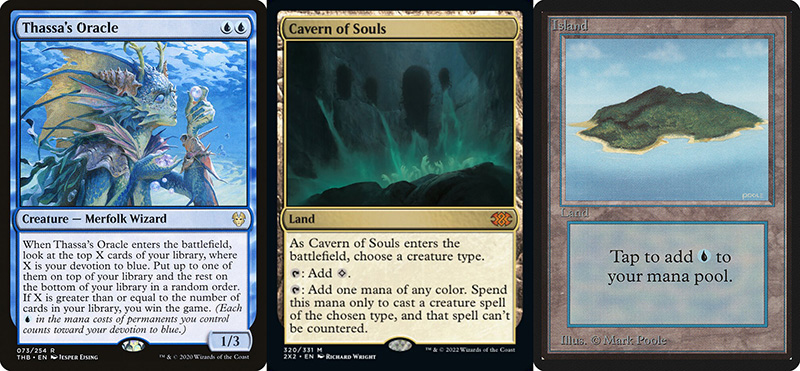
If unopposed, the Oracle deck will win on turn 2 (this was the “house deck” for the week. More on that in a minute). Not surprisingly, combo is weak to counterspells, so Cavern of Souls provides a little extra security.
Player B: Lupine Prototype, Mishra's Workshop, Trinisphere

Player B is looking to lock up the opponent with Trinisphere before playing a 5/5 that can end the game in 4 turns.
Player C: Blackmail, Cruel Sadist, Swamp
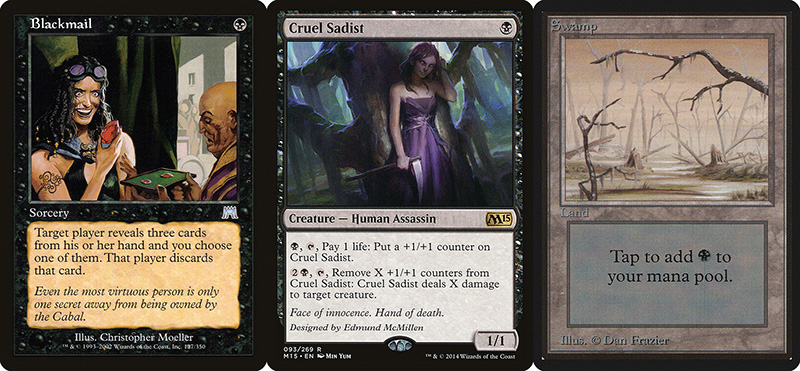
Player C is also playing a control angle, using Blackmail to pluck a critical card from the opponent and then taking their time with Cruel Sadist (which can hopefully get large enough to overcome an opposing blocker that manages to get around Blackmail).
How does it play out?
Player A vs Player B – On the play or on the draw, B can get Trinisphere out before A can play Thassa, completely locking them out since their 2 lands cannot produce 3 mana. (6 points for B, 0 points for A)
Player A vs Player C – Similarly, C can play Blackmail on turn 1, guaranteeing that they can pluck Thassa from the opponent. (6 points for C, 0 points for A)
Player B vs Player C – This one is interesting! When B goes first, they can get their Trinisphere down and prevent Blackmail or Cruel Sadist from being played. When C goes first, they can play blackmail and trash the Lupine Prototype. (3 points for each)
Although it tied in this example, the Blackmail/Cruel Sadist deck was the strongest against the field the week it was submitted. It was able to beat multiple decks that beat the Lupine Prototype deck.
All of these decks take advantage of the unique properties of the format to use cards that would otherwise be underpowered or at least require a lot more hoops to jump through. Thassa's Oracle is certainly powerful in its own right, but usually requires a lot more setup. Blackmail is not usually premium discard, but in this format it can hit every card in the opponent's hand (including lands). Lupine Prototype I had forgotten about entirely, but here it is a reliable 5/5 beater.
Pretty much every link below has other sample matchups that you can check out. These are filled with examples of cards that need to be re-evaluated in the context of 3CB. This is a format that really rewards players who dig for gold in older, mostly forgotten cards.
Resources
Before I dive further into my own event, I want to provide a few links that are helpful for anybody thinking about running a 3CB tournament or who just wants to read about this interesting offshoot of Magic. I certainly would not have been aware of 3CB or able to run my own tournament without them.
MTG Fandom Page – A solid primer and a good reference for the rules.
3-Card Magic by Brian Demars – This article on Channel Fireball was the first time I heard about the format.
Three Card Blind: A Whole Different Format by Goblinboy – A very detailed forum post from 2005 about the format. It's very fun to see the cards from that era evaluated for this format. Does a great job of pointing out cards that are unremarkable in normal Magic, but extremely strong in 3CB and vice versa.
3-Card Blind Metashape Tournament – This was a recent tournament run on Reddit by u/Lognu. My own tournament is heavily based on their setup. That link also has spreadsheets from the game and is a great resource to see decks that people have submitted.
My Tournament's Page – Here's where I laid out the rules for my tournament and maintained the ban-list.
My Tournament Spreadsheet – You can check out my decks submitted each week here! This was where the game took place. Player names have mostly been obscured and all comments have been removed (but they were lively!).
My Tournament
In terms of structure, I was heavily influenced by Lognu's Metashape Tournament. Rather than starting with an extensive ban list (as many 3CB games do), cards from the best performing decks are banned and the list evolves over time. This forces players to come up with new solutions each week.
A lot of the fun of this format is trying to beat the field. Although there are some combinations of cards that are quite strong, there is simply nothing that wins every match. So a huge part of the tournament is trying to figure out the meta and guess which decks other people will play. To this end I introduced one other major gameplay element: the house deck.
Each week, the highest performing deck has two cards banned. Then this deck becomes the house deck. In the following week it will be one of the decks that everybody faces. This is the only deck that players know they will face, so submitting a deck that beats it guarantees 6 points. However, all players know about this can can choose to design their own deck to prey on decks that will beat the house deck. The goal is to provide just enough known info about the next round for savvy players to predict the field. There is also the challenge of forcing players to beat the winning deck without having access to the same cards (since cards in the house deck have been banned).
During the course of the tournament, one player asked if Conspiracy cards could be used. This is a bit of an edge case since they aren't proper cards and are not typically available in constructed play, but I think it's fun when things get weird so I OKed them (with the exception of Power Play, because it undermined the structure of the tournament). I think it would be more than fair to ban them in your own tournament, but I liked the inclusion and they never felt like they broke things.
Ban List
My tournament ran for 5 weeks. In that time the following cards were banned:
- Strip Mine
- Chancellor of the Annex
- Mesmeric Fiend
- Leyline of Anticipation
- Memnite
- Snapback
- Thassa's Oracle
- Cavern of Souls
- Island
- Power Play
Running The Game
Each round was given one week. Here is the cadence I listed in the game description:
- Results will be announced on Monday, including the updates to the ban list.
- Players have until Thursday 3PM EST to submit their decks.
- Players should review their games by Saturday at 8PM.
Decks were submitted by people emailing their lists to a special email account I made for the purpose of this game. This meant that I had to submit my own deck before I officially opened submissions so that I did not see anybody else's deck before locking in my own.
Because players did not see each other's decks, I allowed players to update their decks until the Thursday deadline if they wanted to. I also tried to alert players if I noticed that their deck probably would not play out the way they expected it to, or if it broke some rule and would be disqualified.
On Thursday, a new page was made in the spreadsheet and players could start scoring their decks!
The spreadsheet
Much like Eve Online, this is a game played in spreadsheets.
I based my spreadsheet on the ones that Lognu made. The big difference is that in Lognu's game, players find their row and score themselves going right along each column. The decks are listed on the right, and I figured players know their own deck. So I switched this and had my players find their column and move down, allowing them to easily see the cards they faced in each match.
Here is a a gif I made of Jenny submitting her scores to explain the process to new players. (She has one win against Timmy for 3 points, and no wins against Spike)
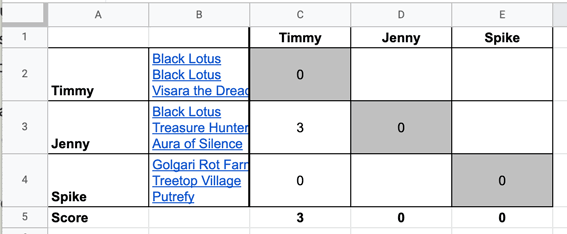
You may notice that this system has duplicate information. For example, the result of cell E2 (Spike vs Timmy) can be derived from cell C4 (Timmy vs Spike). Since Timmy got a 0 against Spike, we know that Spike must have gotten a 6 against Timmy. But there is a reason for this: it means that every game has both players computing the results separately. Magic is a complex game and the optimal play is not always obvious. By having both players evaluate the games independently, there is some built in confirmation of the results. (This was further assisted by other players being generally interested. During the game, there was constant commentary on many of the cells as players discussed how games would play out).
Because I hated the thought of scanning the grid to determine if values did not line up, I wrote some formulas in my sheet to check if the values for a given pair of cells did not match. Then I used conditional formatting to highlight those cells in yellow to alert myself and other players that there was some issue here.
Let's take the same example from above. Let's say Spike shows up but thinks they win one game and tie one game against Timmy.
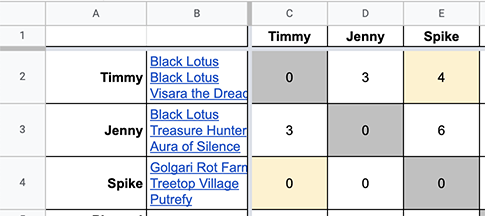
The spreadsheet highlights the cells for that match in yellow. If one cell of a match is 0 (two losses), the other should be 6 (two wins). Alternatively, if one cell of a match is 4 (a win and a tie), the other should be 1 (a loss and a tie). The logic for this is frustratingly complex and I wrote a python script to export the formulas for the 225 cells needed for a 15 player game. If you are curious, you can check out rows 50 to 65 of my template sheet (they're hidden by default but you can expand them if you duplicate the sheet).
If you go through the weeks of my tournament, you'll find a few instances where I had to make a judge call (highlighted in purple), but in at least 90% of cases where the results did not match, players sorted it themselves (often with help from other players weighing in on the result via cell comments). Having the sheet automatically flag disputes did a lot encourage players to reevaluate and fix results. It also provided fun conversation fodder!
It is a credit to the group I was playing with that one of the most frequent disagreement was a player explaining why the other deck would actually beat them.
Week to Week
Dive into the spreadsheet if you want to see all the decks submitted each week. There are some very interesting trends as certain deck types had rises and falls in popularity. What I'm going to present here is the winning deck for each week (which became the house deck for the following week). It's a great microcosm of the strategies at play in 3CB.
Most players asked that I not include their names, but rest assured that none of these winning decks were submitted by me.
Week 1 – Inkmoth Nexus, The Tabernacle at Pendrell Vale, Urborg, Tomb of Yawgmoth

Week 2 – Strip Mine, Chancellor of the Annex, Icatian Store (submitted by NaCl)

Week 3 – Mesmeric Fiend, Leyline of Anticipation, Black Lotus

Week 4 – Memnite, Snapback, Force of Will
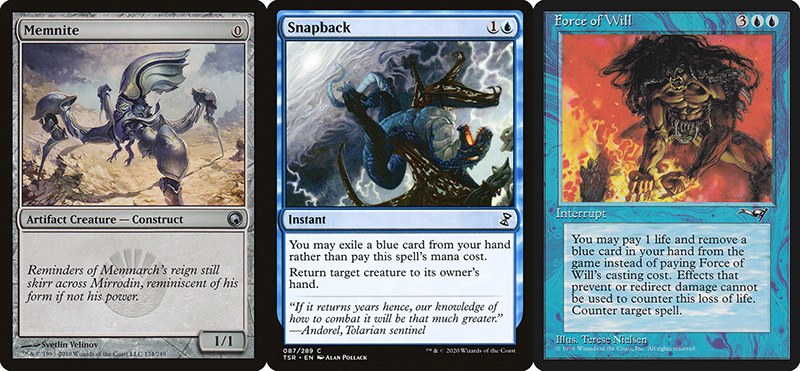
Week 5 – Thassa's Oracle, Cavern of Souls, Island (submitted with only slight variations by 4 players)

Week 6 – Blackmail, Cruel Sadist, Swamp (submitted by NaCl)

You can see how each deck beats the one before it, but not necessarily the one two weeks prior!
Random Thoughts and Notes
Cell comments were an unexpected delight. I originally planned on including all participants on a group email each week to discuss the round, but players started adding comments directly onto the spreadsheet. It was very lively and became a space to discuss cool decks people had made in addition to sorting out tricky matches.
I do wish I had encouraged people to use burner email accounts and usernames. The comments in the spreadsheet are mostly tied to personal email accounts. It didn't occur to me that I might want to share the results of the game in a post like this, and at that point the comments were too linked to personal information. The spreadsheet I posted here has all of the decks, but the commentary and most of the names have been removed.
After one week of manually linking everybody's cards, I started asking players to submit their decks on a single line with each card name being a link to scryfall. It made the process of prepping the sheet much less time consuming.
If I did it again, I would green light conspiracy cards from the jump, as I thought they were a lot of fun.
In this game, I banned two cards from each winning deck (determined by the order in which they were submitted). This resulted in an interesting but slightly slow-moving ban list. In the future I'd ban all 3 cards in the winning deck and possibly take out one or two from other high scoring decks as well.
The house deck did exactly what I wanted it to do. It guided the field just enough that players could strategize around it.
Running Your Own / Using My Spreadsheet
If you are interested in running your own 3CB tournament, you absolutely should! It's a good time and you only need about 5 regular players to make it compelling.
You can use my or Lgnu's rules directly, but it's a lot of fun to make up your own spin on it as well.
If it is helpful, you can duplicate my spreadsheet template and get my nice conditional formatting.
If you do start a new game with this sheet, I'd love to hear about! Hit me up on twitter, mastodon or email me at andy[at]andymakes[dot]com.
While I have you here...
I'm a real sucker for games where people secretly submit their moves for the turn. I've been working on a wargame called Skirmish Society that was inspired by Diplomacy. It's played via Discord bot and you secretly DM your orders to the bot each turn (while plotting and making deals with other players in the public channel and over DM). I'm close to wrapping it up and would love to have a few more test groups. If that sounds fun to you, you can install it on your Discord for free over here!